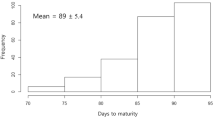Abstract
This study is focused on the selection analysis of high rutin contents in various buckwheat species and cultivars, such as Fagopyrum esculentum Moench. (Cultivars Lileya, Bilshovik, Rubra), F. tataricum G. (ssp. rotundatum (Bab) Krot. and ssp. tuberculatum Krot.), F. cymosum Meissn, and Fagopyrum giganteum Krot. Rutin contents in vegetative organs of plants showed good correlation with anthocyanins contents in vegetative organs of Rubra cultivar. The presence of anthocyanin’s contents in the vegetative organs of buckwheat can be a reliable genetic marker for screening plants with high content of rutin. In the third generation of selection process with the proposed selection method by us, a genetic line of Rubra cultivar with high rutin content in the vegetative mass has been obtained. The proposed method of selection based on the color visual assessment of plant parts of buckwheat which is correlated with anthocyanin contents. The color visual assessment of vegetative organs of buckwheat plants can be marker for selection buckwheat cultivars with high anthocyanin’s and rutin contents.
Zusammenfassung
Diese Studie konzentriert sich auf die Selektionsanalyse hoher Rutinkonzentrationen in verschiedenen Buchweizenunterarten und -sorten wie Fagopyrum esculentum Moench, (Sorten Lileya, Bilshovik, Rubra), F. tataricum G. (ssp. Rotundatum (Bab) Krot. und ssp. Tuberculatum Krot.), F. cymosum Meissn und Fagopyrum giganteum Krot. Der Rutingehalt in vegetativen Organen der Pflanzen zeigte eine eindeutige Korrelation mit dem Anthocyangehalt in vegetativen Organen der Sorte Rubra. Das Vorhandensein von Anthocyanen in den vegetativen Organen von Buchweizen kann ein verlässlicher genetischer Marker zum Screenen von Pflanzen mit hohem Rutingehalt sein. In der dritten Generation des Selektionsverfahrens mit der in der Studie vorgeschlagenen Selektionsmethose wurde eine genetische Linie der Sorte Rubra mit hohem Rutingehalt in der vegetativen Masse erzielt. Die vorgeschlagene Selektionsmethode basiert auf der optischen Einschätzung der Farbe von Pflanzenteilen des Buchweizens, die mit dem Anthocyangehalt zusammenhängt. Die optische Einschätzung der Farbe vegetativer Organe von Buchweizenpflanzen kann ein Marker zur Selektion von Buchweizensorten mit hohem Gehalt an Anthocyanen und Rutin sein.

Similar content being viewed by others
References
Aherne SA, O'Brien NM (1999) Protection by the flavonoids myricetin, quercetin, and rutin against hydrogen peroxide-induced DNA damage in Caco-2 and Hep G2 cells. Nutr Cancer 34(2):160–166
Couch JF, Naghski J, Krewson CF (1952) Rutin content of Sophora japonica L. J Am Chem Soc 74(2):424–425
Ehlting J, Shin JJK, Douglas CJ (2001) Identification of 4-coumarate: coenzyme a ligase (4CL) substrate recognition domains. Plant J 27:455–465
Giusti MM, Wrolstad RE (2001) Unit F1.2: Anthocyanins. Characterization and measurement with UV-visible spectroscopy. In: Wrolstad RE (ed) Current protocols in food analytical chemistry, John Wiley & Sons, New York, 1–13
Hamamatskui S, Yabe M, Nawa Y (2004) Compositions of anthocyanin and other flavonoids in cultured cells rabbiteye blueberry (Vaccinium ashei Reade cv. Tiiblue). Food Sci Technol Res 10(3):239–246
Holasova M, Fiedlerova V, Smrcinova H, Orsak M, Lachman J, Vavreinova S (2002) Buckwheat—the source of antioxidant activity in functional foods. Food Res Int 35(2–3):207–211
Hollman PC, Katan MB (1999) Dietary flavonoids: intake, health effects and bioavailability. Food ChemToxic 37:937–942
Klykov A, Moiseenko L (2003) Method of selection buckwheat plants with high rutin content in the aboveground mass. RU 2255466 C2
Kreft I, Fabjan K (2006) Rutin content in buckwheat (Fagopyrum esculentum Moench) food materials and products. Food Chem 98:508–512
Kreft S, Knapp M, Kreft I (1999) Extraction of rutin from buckwheat (Fagopyrum esculentum Moench) seeds and determination by capillary electrophoresis. J Agric Food Chem 47(11):4649–4652
Krotov A, Dranenko E (1973) Amphidiplod buckwheat. Rep Inst Plant Ind 3:41–44
Leiber F, Kunz C, Kreuzer M (2012) Influence of different morphological parts of buckwheat (Fagopyrum esculentum) and its major secondary metabolite rutin on rumen fermentation in vitro. Czech J Anim Sci 57(1):10–18
Muraki I, Imamura F, Manson JE, Hu FB, Willett WC, van Dam RM, Sun Q (2013) Fruit consumption and risk of type 2 diabetes: results from three prospective longitudinal cohort studies. BMJ 347:f5001. doi: 10.1136/bmj.f5001
Oomah BD, Mazza G (1996) Flavonoids and antioxidative activities in buckwheat. J Agricul Food Chem 44(7):1746–1750
Park CH, Kim YB, Choi YS, Heo K, Kim SL, Lee KC, Chang KJ, Lee HB (2000) Rutin content in food products processed from groats, leaves, and flowers of buckwheat. Fagopyrum 17:63–66
Rana JC, Sharma BD (2000) Variation, genetic divergence and interrelationship analysis in buckwheat. Fagopyrum 17:9–14
Singleton VL, Rossi JA (1965) Colorimetry of total phenolics with phosphomolybdic-phosphotungstic acid reagents. Am J Enol Vitic 16:144–158
Taylor LP, Grotewold E (2005) Flavonoids as developmental regulators. Curr Opin Plant Biol 8:317–323
Velioglu YS, Mazza G, Gao L, Oomah BD (1998) Antioxidant activity and total phenolics in selected fruits, vegetables, and grain products. J Agric Food Chem 46:4113–4117
Verardo V, Arráez-Román D, Segura-Carretero A, Marconi E, Fernández-Gutiérrez A, Cabon MF (2011) Determination of free and bound phenolic compounds in buckwheat spaghetti by RP-HPLC-ESI-TOF MS: effect of thermal processing from farm to fork. J Agric and Food Chem 59(14):7700–7707
Wang LS, Stoner GD (2008) Anthocyanins and their role in cancer prevention. Cancer Lett 269(2):281–290
Acknowledgement
The authors are indebted to would like to thank James Hamilton and Lothar Eichler for their helpful comments on an earlier draft.
Author information
Authors and Affiliations
Corresponding author
Rights and permissions
About this article
Cite this article
Sytar, O., Kosyan, A., Taran, N. et al. Anthocyanin’s as marker for selection of buckwheat plants with high rutin content. Gesunde Pflanzen 66, 165–169 (2014). https://doi.org/10.1007/s10343-014-0331-z
Received:
Accepted:
Published:
Issue Date:
DOI: https://doi.org/10.1007/s10343-014-0331-z




